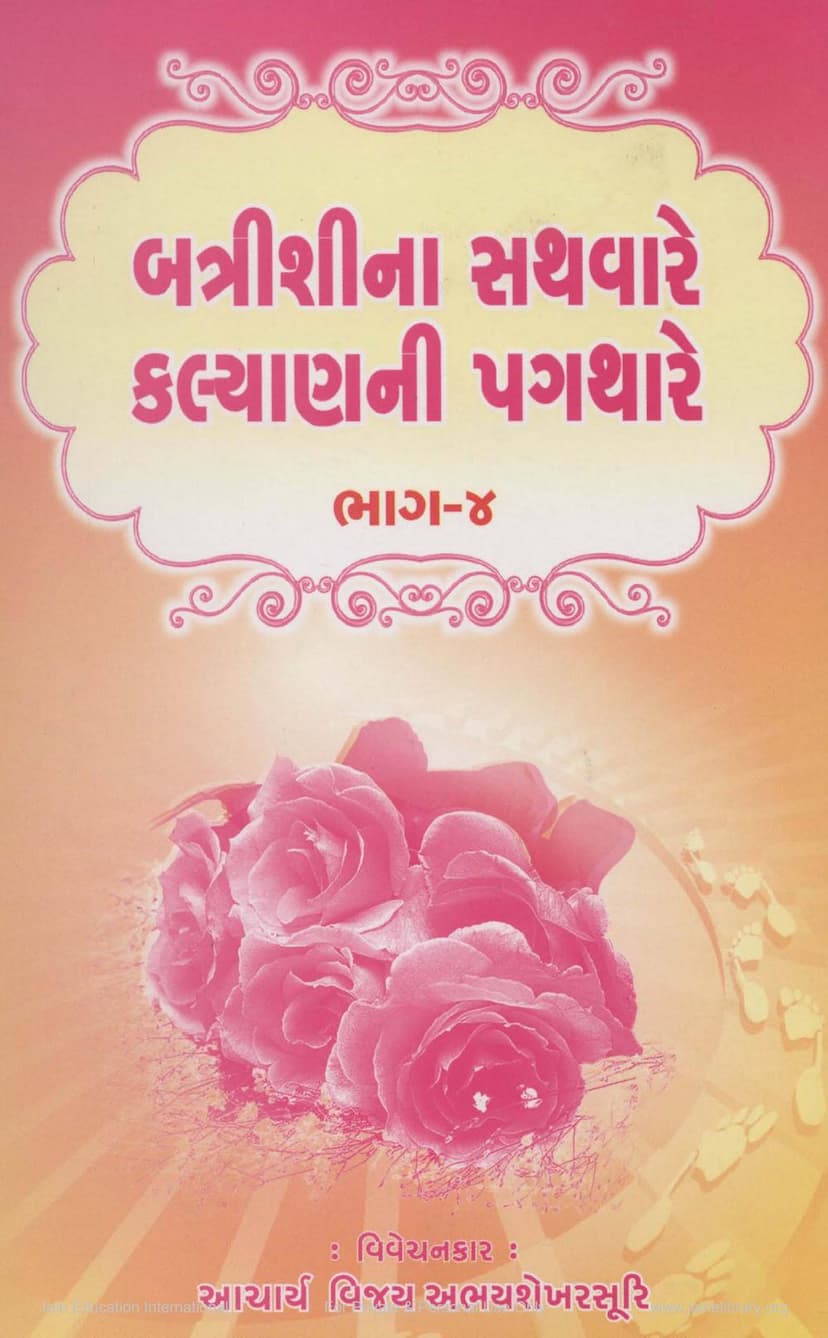Battrishina Sathware Kalyanni Pagthare Part 04
Added to library: September 1, 2025

Summary
This document is the fourth part of a series titled "Battrishina Sathware Kalyanni Pagthare" (On the Path to Salvation with the Support of the Thirty-Two) by Acharya Vijay Abhayashekhar Suri. Published by Divya Darshan Trust, this volume focuses on the tenth "Battreeshi" (a collection of 32 themes or teachings) from the work "Dwaadash Dwaatrishika" by Mohopaadhyaya Shrimad Yashovijayji Maharaj.
The book is dedicated to the birth centenary of His Holiness Gurudev Shri Bhuvanbhanusurishwarji Maharajsaheb. Acharya Vijay Abhayashekhar Suri is recognized for his ability to simplify complex scriptural concepts for a wider audience.
The core theme explored in this part, particularly in the articles numbered 48 to 61, is "Yoga" as the fruit of religious discourse. The text begins by defining 'Yoga' as that which unites the soul with liberation.
Key discussions revolve around:
- The nature of 'Yoga': It's not just any religious action but specifically those actions that lead to liberation. The text clarifies that 'Yoga' is achieved when Dharma Kriya (religious action) is accompanied by specific mental states or intentions known as 'Aashayas'.
- The role of 'Aashayas' (Intentions/Attitudes): The text delves into five crucial 'Aashayas' that transform religious actions into 'Yoga':
- Pranidhaan (Firm Resolve): A steadfast commitment to a spiritual goal, like attaining non-violence or forgiveness, without wavering even in adversity.
- Pravrutti (Action/Engagement): Energetic and skillful engagement in the means to achieve the spiritual goal, free from haste or selfish desires.
- Vighnajay (Overcoming Obstacles): The ability to conquer external (like weather) and internal (like mental delusions, attachment to body) obstacles without losing one's spiritual resolve or momentum. This is further categorized into overcoming minor, moderate, and severe obstacles.
- Siddhi (Realization/Attainment): The direct, experiential realization of one's true nature (like non-violence as an inherent quality, not just a practice) and the ensuing virtuous qualities.
- Viniyog (Application/Sharing): The act of imparting one's realized spiritual qualities or practices to others, thereby fostering their spiritual growth and ensuring the continuation of one's own spiritual progress.
- The distinction between 'Yoga' and mere 'Dravya Kriya' (Material Action): Actions performed without these 'Aashayas' are considered 'Dravya Kriya' and are seen as less significant in the path to liberation, even if they appear virtuous externally.
- The concept of 'Charmaavarta' and 'Acharmaavarta': The text explains why 'Yoga' is primarily associated with the 'Charmaavarta' (final cycle of existence) and less so with 'Acharmaavarta' (earlier cycles). This is linked to the 'Bhavabhinandi' (one who loves worldly existence) nature of beings in 'Acharmaavarta', who are driven by external attractions and lack the necessary internal spiritual resolve.
- The characteristics of 'Bhavabhinandi': The text details eight negative traits of such beings: miserliness (kshudra), covetousness (lobharati), dejection (deen), envy (matsari), fearfulness (bhayabhit), deceitfulness (shath), ignorance (agn), and futility of actions (nishphal aaraambh-sangat). These traits prevent them from developing the necessary 'Aashayas'.
- The importance of internal attitude: The text repeatedly emphasizes that the internal mental state, the 'Aashaya', is what truly transforms an action into 'Yoga'. Even outwardly virtuous actions can be mere 'Dravya Kriya' if the underlying intention is not aligned with spiritual progress.
- The role of 'Sanskaras' (Impressions): The text highlights how repeated intentions and actions create inner impressions that influence future behavior, emphasizing the need to cultivate positive 'Sanskaras' through the right 'Aashayas'.
In essence, this part of the series guides the reader on how to imbue their daily religious practices with a profound spiritual purpose and inner resolve, transforming them from mere rituals into powerful means for achieving ultimate liberation. It emphasizes that genuine spiritual progress is rooted in the quality of intention and inner attitude, rather than just outward observance.